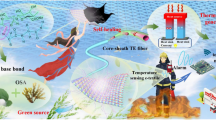Abstract
Oxide fibers find many uses as insulation and as reinforcements. The most widely known oxide fiber is glass fiber, which has a composition based on silica (SiO2), but other minerals are added to control their characteristics. One such addition is alumina (Al2O3), which increases mechanical properties and also resistance to high temperature. Al2O3 occurs in many transitional forms, all of which are converted to α-Al2O3 if heated above around 1,200°C. A range of fibers exists with compositions consisting of both Al2O3 and SiO2, and a number of manufacturing processes are used to produce them.
Similar content being viewed by others
References
P.K. Gupta, “Glass Fibers for Composite Materials,” Fibre Reinforcements for Composite Materials, ed. A.R. Bunsell (Amsterdam: Elsevier, 1988), pp. 19–71.
Eiji Horie, ed., Ceramic Fiber Insulation Theory and Practice (Osaka, Japan: The Energy Conservation Center, 1986), pp. 43–150.
J.D. Birchall, Concise Encyclopedia of Advanced Ceramic Materials, ed. R.J. Brook, (Oxford: Pergamon Press 1991), pp. 236–238.
M.J. Morton, J.D. Birchall, and J.E. Cassidy, UK Patent Specification 1360197, 17 July 1974.
Y. Abe et al., Proc. 4th Int. Con. Composite Mater. (Tokyo, Japan: Japan Society for Composite Materials, 1982), p. 142.
Y. Saibow et al., Proc. 37 Int. SAMPE Symp. and Exhib., 35 (Covina, California: Society for the Advancement of Materials and Processing Engineering, 1992), pp. 808–819.
A. Poulon-Quintin, M-H. Berger, and A.R. Bunsell, J. European Ceramics Society, 24 (2004), pp. 2769–2783.
A.R. Bunsell and M-H. Berger, Fine Ceramic Fibers (New York: Marcel Dekker, 1999), pp. 111–164.
D.M. Wilson, S.L. Lieder, and D.C. Lueneburg, Ceram. Eng. Sci. Proc. 16 (Westerville, Ohio: The American Ceramic Society, 1995), pp. 1005–1014.
F. Deleglise, M-H. Berger, and A.R. Bunsell, High Temperature Ceramic Matrix Composites, ed. W. Krenkel, R. Naslain, and H. Schneider (Weinheim, Germany: Wiley VCH, 2001), pp. 84–89
F. Deleglise et al., J. European Ceramic Society, 21 (2001), pp. 569–580.
H.E. Labelle, Jr., Method of Growing Crystalline Materials, U.S. patent No 3,591,348 (1971).
J.T.A. Pollock, J. Mat. Sci., 7 (1972).
S.T. Mileiko et al., Composites Sci. & Tech., 59 (1999), pp. 1763–1772.
M. Akiyama “Ceramic Fibres,” Fibre Reinforcements for Composite Materials, ed. A.R. Bunsell (Amsterdam: Elsevier, 1988), pp. 427–478.
Author information
Authors and Affiliations
Additional information
For more information, contact A.R. Bunsell, Ecole des Mines de Paris, Centre des Matériaux, BP 87, Evry Cedex, France; 33 (0) 160753015; e-mail anthony.bunsell@ensmp.fr.
Rights and permissions
About this article
Cite this article
Bunsell, A.R. Oxide fibers for high-temperature reinforcement and insulation. JOM 57, 48–51 (2005). https://doi.org/10.1007/s11837-005-0216-9
Issue Date:
DOI: https://doi.org/10.1007/s11837-005-0216-9




